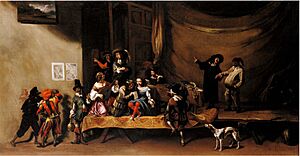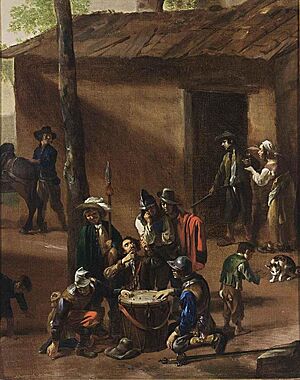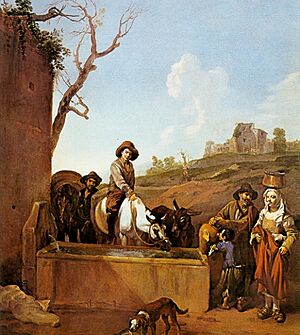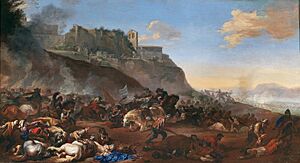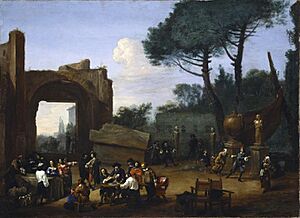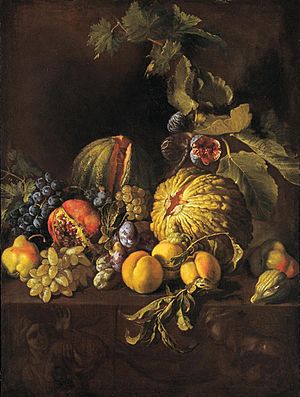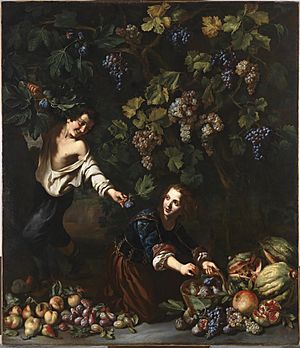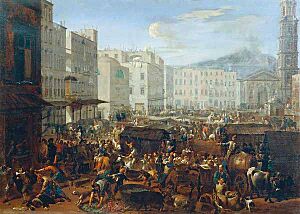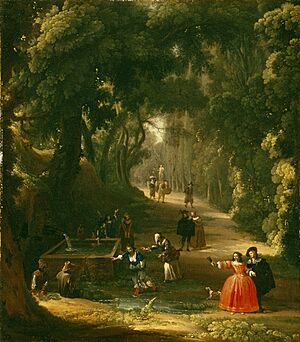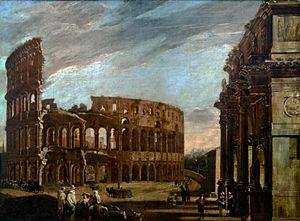Michelangelo Cerquozzi facts for kids
Michelangelo Cerquozzi (born February 18, 1602 – died April 6, 1660) was a famous Italian painter from the Baroque period. He was also known as Michelangelo delle Battaglie, which means 'Michelangelo of the Battles'. He painted many different types of scenes. These included everyday life scenes, exciting battle pictures, small religious and mythological artworks, and beautiful still lifes.
His paintings of everyday life were inspired by artists from Flanders and the Netherlands. These artists were called the Bamboccianti. They lived in Rome and created small paintings and prints. These artworks showed the daily lives of ordinary people in Rome and the countryside. Cerquozzi was also one of the best battle painters in Italy during the early 1600s. This is how he earned his special nickname.
Contents
Life of Michelangelo Cerquozzi
Michelangelo Cerquozzi was born in Rome. His parents, Marcello Cerquozzi and Lucia Vassalli, were Roman citizens. His father was a successful leather merchant, so his family was quite wealthy. Michelangelo began his art training when he was 12 years old. He studied in the studio of Giuseppe Cesari. This was the same studio where the young Caravaggio trained when he first arrived in Rome.
Many people who wrote about Cerquozzi say he was close to the Flemish and Dutch artists in Rome. Around 1620-1621, he might have lived or worked with Jacob de Hase. Jacob de Hase was a battle painter from Antwerp. Cerquozzi might have even studied with him earlier. In 1624, he lived with Dutch painters Paulus Bor and Jan Harmansz. From 1625 to 1630, he lived with Willem Michiels from Flanders. By 1631, he shared a studio with his student Matteo Bonicelli and Michiels.
We don't know much about his early paintings. He created some battle paintings. He also made still life paintings that looked like the work of Pietro Paolo Bonzi. Bonzi was a specialist in still life art.
Cerquozzi joined the Accademia di San Luca in 1634. This was a famous art academy in Rome. He attended their meetings until 1652. However, he didn't always follow their strict rules for art.
Cerquozzi started to become well-known around 1630. His artworks sold very well to all kinds of people. An early supporter, a merchant named Dominico Viola, helped start his career. He also received painting jobs from important people. These included lawyers, doctors, and even rich families like the Barberini family and the Colonna family. Many of his supporters were on the side of Spain in Italy. Cerquozzi also helped with designs for a book called De Bello Belgico. This book celebrated the military actions of Alessandro Farnese in the Spanish Netherlands.
His friends included famous artists like Pietro da Cortona, Giacinto Brandi, and Cornelis Bloemaert. His students included Matteo Bonicelli and Giovanni Francesco Gerardi.
Cerquozzi never got married and did not have children. He passed away on March 29, 1660, in his home near the Spanish Steps in Rome. By then, he had become a very wealthy artist. He owned a lot of money and property.
Michelangelo Cerquozzi's Artworks
General Art Style
Michelangelo Cerquozzi is most famous for his small paintings of everyday life. He is also known for his exciting Baroque battle scenes. People also recognized Cerquozzi as a great still life painter. His varied career also included religious and mythological paintings. Cerquozzi only completed one public art job in Rome. This was a painting in the Church of Sant’Andrea delle Fratte, but it has been lost. He is also said to have painted altarpieces for churches in Sardinia.
Cerquozzi's religious paintings are usually small. Like his everyday life scenes, they show small, realistic figures in natural outdoor settings. His mythological paintings, like Hercules, also show characters in a peasant-like world. He also painted some allegorical works. These paintings showed ideas or seasons as people, such as Summer and Spring (both at the Ashmolean Museum).
Battle Paintings
Michelangelo Cerquozzi earned his nickname 'Michelangelo delle Battaglie' because of his battle paintings. In these works, he used the style of the Bamboccianti artists. Cerquozzi used a direct and powerful way of painting. He showed the raw truth of battle. Some of his battle paintings were influenced by scenes from Salvator Rosa. An example is the "Battle" in the Galleria Nazionale in Rome.
He made important contributions to battle painting with his small canvases. These paintings show a close-up view of a battle. They are often dominated by an intense fight between cavalry, with horses and men moving wildly. These works influenced later battle painters like Jacques Courtois.
Genre Scenes (Everyday Life)
In his genre scenes, Cerquozzi showed how much he learned from the Bamboccianti. This was a group of Dutch and Flemish painters around Pieter van Laer and Jan Miel. They created a new style in Rome. This style came from Northern traditions of painting everyday life. A painting in this style was called a Bambocciata. The Bamboccianti brought new subjects to Roman painting. These included, as one writer said, "rogues, cheats, pickpockets, groups of drunks, barbers, and other 'ordinary' subjects."
In his early genre works, Cerquozzi showed he was skilled in the style of Pieter van Laer and Jan Miel. His paintings were small, showed ordinary subjects, and used strong light and shadow effects. In these works, Cerquozzi explored the simple lives of Roman people. He showed them among ruins, in taverns, and having arguments. He often set these scenes in Rome and the nearby countryside. Cerquozzi didn't just copy these Flemish and Dutch artists. He focused more on telling a story and adding small details from daily life. He also included people of higher social standing. This was also seen in Jan Miel's work in the 1640s and 1650s.
Cerquozzi's Party in a garden with Roman artists (in Kassel, Gemäldegalerie Alte Meister) shows typical bambocciata features. It looks very natural and is a small painting. However, instead of showing only common people, it shows groups of well-dressed men and women. These include the artist himself, his doctor Vincenzo Neri, and other friends talking and playing games.
Some art historians thought the Bamboccianti style showed a true picture of Rome's everyday life. But people at the time didn't always see them as realists. Another idea is that their works were complex allegories. This means they used simple subjects to talk about deeper ideas. They were part of a long tradition where ordinary things could carry important meanings.
Important Italian painters in Rome and Bologna, like Sacchi and Reni, openly disliked Cerquozzi's style. However, the Bamboccianti could still be accepted into the Accademia di San Luca. This was a very important group for artists in Rome. Cerquozzi was even accepted into the Accademia in 1634 when he was only 30 years old. Other artists might have disliked the Bamboccianti because their paintings were often cheaper. This created strong competition for "serious" painters. This was especially true in the late 1640s and 1650s when the economy was not good. But, the most successful Bamboccianti, like Cerquozzi, could actually sell their works for high prices.
Still Life Paintings
Cerquozzi painted still life pictures throughout his career. His early still life paintings copied the style of Pietro Paolo Bonzi. Bonzi was a specialist in still life art. These paintings showed fruits in a very realistic way. They were influenced by Caravaggio. Cerquozzi later started to create large still life paintings that included life-size figures.
Examples of his still life paintings are the Youths picking fruit (1640-1645, Prado Museum) and the Harvest of pomegranates (after 1640, Museum Boijmans Van Beuningen). Both show a young man and a young woman in an orchard. The man is offering the sitting woman a piece of fruit. A still life of fruit is in front of them. The figures clearly show the influence of Caravaggio's natural style. The young man's expression and open white shirt remind us of some of Caravaggio's early works. The amazing way the vine leaves and grapes are painted in the Prado piece brings to mind Caravaggio's Basket of fruit.
However, the rich look of the pumpkins, the open pomegranate, and the landscape in the background show a more advanced style. They show full Baroque influences. The freedom of vision and outdoor setting of these paintings show Cerquozzi as a link from Caravaggio to the Baroque style.
The idea of picking fruit and offering it to a young woman was common in the Low Countries in the 1500s. In the Harvest of pomegranates, the young man offers a pomegranate to the young woman. For centuries, the pomegranate was a symbol of fertility and plenty. This is likely because it contains so many seeds.
He was very successful with his still lifes. They often appear in art lists from the 1600s and 1700s.
Artistic Collaborations
Cerquozzi often worked with other painters who specialized in landscapes and buildings. These included collaborations with the architectural painter Viviano Codazzi (starting in the 1630s) and the landscape painter Angeluccio.
Cerquozzi and Codazzi worked together often. Codazzi's paintings usually showed ancient ruins and monuments. Their teamwork probably made Cerquozzi paint less about rural life and more about grander and more unusual subjects. In 1657, the two artists worked on several paintings for Cardinal Flavio Chigi. He was one of the most important art supporters of his time. Some of the paintings for Cardinal Chigi had very original subjects.
In 1648, Cerquozzi worked with Viviano Codazzi on a painting called the Revolt of Masaniello. This artwork shows the rebellion against Spanish rule. It happened on July 7, 1647, in Naples. France supported this rebellion. Cerquozzi showed his observations of the event from a wide and challenging viewpoint. He used the natural bambocciata style to create a heroic and funny picture of the revolt. He painted a lively historical scene in miniature. It shows the town square, angry people, small thieves, and animals. All of this is surrounded by a wide view of the city that opens up to Vesuvius.
This single painting shows different events that happened during the rebellion. The leader of the rebellion appears on a horse in the front center of the painting. Unlike a painting of the same event by Domenico Gargiulo, Cerquozzi showed the anti-Spanish revolt in a fair and objective way. This was true even though he was generally seen as being pro-Spanish. A pro-French cardinal had actually ordered this painting. Cerquozzi, who painted everyday life and battle scenes, was a good choice for the cardinal. The historic rebellion was still considered "news" when the painting was ordered.
In 1647, Cerquozzi worked with Jan Miel, Giacomo Borgognone, and others. They created illustrations for the second book of Famiano Strada's De Bello Belgico. This book celebrated the military actions of Alessandro Farnese in the Netherlands for the Spanish emperor.
Images for kids
See also
 In Spanish: Michelangelo Cerquozzi para niños
In Spanish: Michelangelo Cerquozzi para niños


